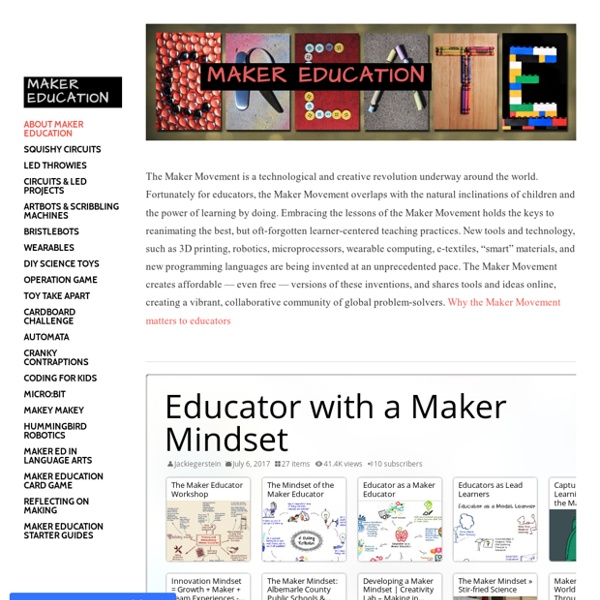



http://www.makereducation.com/
Related: Educator with a Maker Mindset • Makerspaces • MAKER EDUCATIONMakerSpace Reflections #makered #ctedu On Tuesday, I’m participating as a moderator and discussion-group leader with the Connecticut Education group on Twitter, talking about MakerSpaces in schools. That’s on Twitter from 8:00pm to 8:30pm (eastern time), on Tuesday 28 July 2015, on the #ctedu hashtag. My co-moderators are David Saunders, who wrote about this makerspaces conversation here, and Nicholas Provenzano, otherwise known as the Nerdy Teacher. Origins But it occurred to me that I should write about this a bit beforehand, so that people know where I’m coming from. Challenge Based Learning in Makerspaces Design challenges have the power to encourage creativity in your students – by providing limitations and guidelines, students can actually become more creative. Learn strategies for creating design prompts, running challenges and incorporating the design process into projects with your students. We’ll discuss how to create open-ended challenges and material-specific challenges in a way that will maximize your students’ creativity, as well as how to create passive design challenges that require minimal supervision.
A Makerspace Built by Elementary Students When Ocean City Primary School, where I work, asked a group of 8-year-olds to create something, the students were given one design requirement: Whatever they created had to better the school community and solve a problem. This allowed students to be creative and explore their interests in addressing a real-world issue. Students realized that they had an authentic opportunity to make a difference in their school. Six Steps to an Engaging Makerspace 1. Guide and facilitate: Initially, the students generated typical 8-year-old responses, like, “A robot that does your homework for you!”
How the Maker Movement Is Moving Into Classrooms In 1972, Seymour Papert predicted what many complain is the state of today's apps and programs for modern students: [T]he same old teaching becomes incredibly more expensive and biased toward its dumbest parts, namely the kind of rote learning in which measurable results can be obtained by treating the children like pigeons in a Skinner box. Indeed, many of us go on first our first techno-rush as kids playing with erector sets, Legos, and the Radio Shack electronic kits. In a day when everyone thinks, "There's an app for that," many educators believe that we're missing the point of technology if we think its best use is programming kids to memorize math facts. Students don't want to use apps -- they want to make them.
Making MAKEing More Inclusive Update/Addendum: Last evening I traveled to Albuquerque with a friend to see the makerspace there and attend their monthly meeting. It is a very well-appointed makerspace and there was good attendance for the meeting. I discussed with my friend on the drive back home my concern with the homogeneous demographic make-up of those in attendance. They were mostly white men and women who seemed to have a comfortable income. I stated that given that this makerspace is fairly well established with a five year history, the folks running the space should now be more proactive in increasing the diversity of their membership and becoming more inclusive. My friend took issue with my comment, saying that this is not their purpose.
Part 5… 14 Amazing Project Sites…. A STEM, PBL, Common Core Series… A Goldmine of Resources Welcome to a series that is must read for any PBL or STEM educator. It will include information to reflect and build upon as you consider both PBL and STEM. Best of all, it will finish with over 50 amazing resources you will want to investigate. First, to ensure you do not miss one of these valuable posts or other resources covering PBL, Digital Curriculum, Web 2.0, STEM, 21st century learning, and technology integration please sign up for 21centuryedtech by email or RSS. As always, I invite you to follow me on twitter (@mjgormans).
Creating an Authentic Maker Education Rubric While many teachers are excited about the maker movement and may even be creating projects for their classrooms, assessment can be puzzling even to veteran classroom teachers. How can teachers prove that deep, rich learning is occurring through making? How do we justify a grade to students and parents alike, especially to the student who "just isn’t good at art"? By crafting a three-part rubric that assesses process, understanding, and product, teachers can rest assured that they are covering all the bases. Dissecting the Un-Makerspace: Recycled Learning It starts with a twist, a squeak, and a cheer. Watch out, 1980s cassette player, broken computer mouse, old monitor -- my fifth graders and I are looking for you! Your future doesn't hold a dumpster in it, at least not yet. You, my memory of past innovation, get a second life.
Project-Based Learning Through a Maker's Lens The rise of the Maker has been one of the most exciting educational trends of the past few years. A Maker is an individual who communicates, collaborates, tinkers, fixes, breaks, rebuilds, and constructs projects for the world around him or her. A Maker, re-cast into a classroom, has a name that we all love: a learner. A Maker, just like a true learner, values the process of making as much as the product. In the classroom, the act of Making is an avenue for a teacher to unlock the learning potential of her or his students in a way that represents many of the best practices of educational pedagogy. A Makerspace classroom has the potential to create life-long learners through exciting, real-world projects.